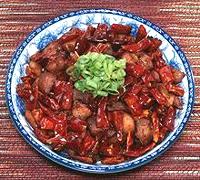 China is not widely known as a land of Chilis, and
many regions are quite adverse to them, but their use is becoming more
widespread due to the increasing popularity of the cuisines from the five
most southern provinces: Sichuan, Hunan, Yunnan, Guizhou, and Guangxi.
China is not widely known as a land of Chilis, and
many regions are quite adverse to them, but their use is becoming more
widespread due to the increasing popularity of the cuisines from the five
most southern provinces: Sichuan, Hunan, Yunnan, Guizhou, and Guangxi.
Like everywhere else, it was the Portuguese who brought hot chilis to China, to Zhejiang by 1671. They aren't recorded in Sichuan until 1749.
The cuisines of Sichuan and Hunan are very distinctive, and have become quite popular outside the region, both in China and in the West. The cuisines of Yunnan, which borders Burma, Thailand, Laos, Sichuan, and Hunan are much less known. They are more similar to those of Southeast Asian, and vary with the many ethnicities that live there.
The cuisines of Guizou are also little known. They are mostly a
patchwork of dishes adopted from the other southern regions, but also a
lot from the Cantonese (Guangdong) to the east. The cuisines of
Guangxi, which borders on Yunnan, Hunan, Guizou, Guangdong and Vietnam,
are so little known, Wikipedia has only four rather non-specific lines
with an error on one - and that could be the definition of "little known".
More on Chili Peppers.
Many more Chili varieties are grown in China, including many local varieties, but the ones listed here are predominant enough to be named export items.
 [Er Jing Tiao; Two Vitex; C.annuum]
[Er Jing Tiao; Two Vitex; C.annuum]
This is a unique chili, with a strong aroma and taste, but with very moderate heat, at about H3. It is used in many ways, dried and ground to flakes or powder, as an ingredient or as a dry dip.
This chili is so mild it is often eaten as a vegetable, green or red, as Anaheim chilis are here, seasoned with salt and soy sauce, or in recipes. In Sichuan, it also an essential ingredient in Chili Oil and various sauces. It is particularly essential in the famous Broad Bean Chili Sauce (La-Doubanjiang) of the region. These are up 7 inches long and 1 inch wide (178 x 25 mm).
Subst: Chili Negro
is of similar size, shape, and almost the exact same heat, though a
darker color. It is similarly aromatic, but noticeably sweeter.
Indian Byadagi is of similar
size and shape, and has almost exactly the same heat, but has a lighter
less aromatic taste and much redder color.
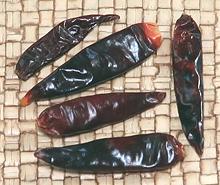 [Chao Tian Jiaom; C.annuum]
[Chao Tian Jiaom; C.annuum]
These get their name from ripening point up. They are great chilis to
use when you want a decorative scattering of chilis that aren't very hot,
as in Sichuan Chicken or Kung Pao Chicken. They look fierce, but have low
heat, about H3 - though a few
can surprise. These are up to 2-3/4 inches long and 0.58 inch wide
(70 x 15 mm). Subst: The closest we have in North
America is the Japones, but they are quite a bit hotter. For primarily
decorative purposes, this should not be a problem.
 [Zi Dan Tou]
[Zi Dan Tou]
This is a medium hot chili, often used by chefs as the whole chilis
scattered in Mala Chicken or Kung Pao Chicken stir fry. It has good
flavor and is moderately hot at low to mid
H7. They are up to 2-3/4 inches long and 0.88 inch wide at
the big end (70 x 22 mm). Subst: While slightly different
in shape and flavor, and just a little hotter, the common Japones are an
acceptable substitute, especially for decorative applications.
 [Deng Long Jiao]
[Deng Long Jiao]
A short, wide, intensely red chili of relatively moderate heat, about
H3 at most. This chili is often
used as a decorative item in Sichuan cuisines. The largest in the batch
was 1.45 inches long, 1.31 inches diameter and nearly weightless. They
were imported from Guizhou China.
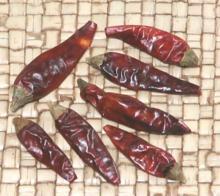 [Xiao mi la, Stars-in-the-Sky Chili (Man tian xing); C frutescens]
[Xiao mi la, Stars-in-the-Sky Chili (Man tian xing); C frutescens]
These little guys are hot enough to make the Chinese see stars, but
still not quite as hot as Thai Bird Chilis. They were used mostly in
Yunnan province, which borders Burma, Thailand and Laos, but have now
really caught on with Sichuan chefs, red, green and dried. Hotness is
about H8, and they are up to
1-3/4 inches long by 0.48 inch wide (45 x 12 mm). Subst:
Thai chilis.
 [Chinese Chili Pepper; Tien Tsin (China); Hontaka, Santaka, (Japan);
C. annuum]
[Chinese Chili Pepper; Tien Tsin (China); Hontaka, Santaka, (Japan);
C. annuum]
This chili originated in Jalisco, Mexico, but has become well known in
South and Southeast Asia, and are grown very extensively in China,
the second largest Chili exporter in the world (but less than half
India's exports). They are easily identifiable by having no caps or
stems. In North America, this is pretty much the default dried red
chili, available everywhere. It has good flavor and is moderately hot
at low to mid H7. They are
up to 2-3/4 inches long and 0.63 inch wide (70 x 16 mm) and fairly
plump.
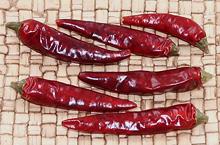 [Qixingjiao; C frutescens]
[Qixingjiao; C frutescens]
Another "heaven pointing chili", this is the hottest chili grown in
Southern China, and the one official for chili eating contests there.
They can be up to 2-1/2 inches long and 0.5 inch wide. Hotness is
H9 (60,000 SU). These are
interchangeable with Dried Red Thai Chilis from Thailand, and are
hotter than what are sold as Thai Chilis here in North America.
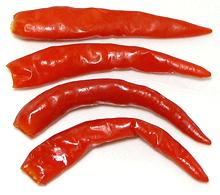 [C. annuum]
[C. annuum]
These pickled red chilis are important to the cuisine of Hunan, China and
surrounding regions . They are best naturally salt fermented, but those
aren't much available in North America. Ubiquitous in all Asian markets
here in California is the Thai product shown in the photo. Apparently
these are sufficiently acceptable to the cuisines that use pickled red
peppers, it isn't urgent to have other types. These range from 2-1/4 to
2-3/4 inches long and are moderately hot, around
H4.
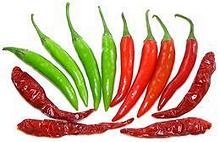 [Rat Turd Chili, Prik Ki Nu (Thai); Mak Pet Ki Nuu (Laos); Nga Yut Thee
(Burma); Scuds (some chefs); C. annuum]
[Rat Turd Chili, Prik Ki Nu (Thai); Mak Pet Ki Nuu (Laos); Nga Yut Thee
(Burma); Scuds (some chefs); C. annuum]
Currently (2020), Sichuan chefs have become enamored with the
Xiao mi la (Rice Grain Chili) from Yunnan, fresh green and red, as
well as dried. We do not have much access to these at this time in North
America, but this variety of Thai Chili is very much available in all
three stages, and will be of similar heat. It is small, often less than
1-3/4 inches long as grown in Thailand, but those grown in California
are often up to 2-3/4 inches. They are narrow, pointy and start growing
point up, but turn downward as they reach full size. They turn from
green to red when ripe, and may be orange in between. They are very hot
(H8 to H9), slightly less
hot when red ripe, and a little less than that when dried.
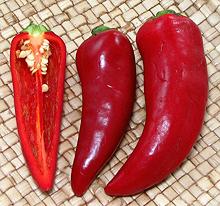 ["Red Jalapeno" (U.S. supermarkets); C. annuum]
["Red Jalapeno" (U.S. supermarkets); C. annuum]
This is not a Chinese chili (at least not yet), but it has been
chosen by all ethnicities in Southern California as the medium hot fresh
red chili suitable for their cuisines. Their hotness is about
H4-5. Core and seed them, but
leave in the membranes (where the heat is) if you want heat. With the
membranes carefully removed they have little heat. They have good
flavor, and the walls are quite thick, so they are not dried. For details
see our Fresno Chili page.
 [C. annuum]
[C. annuum]
These are not a Chinese chili (yet), but they are now quite popular in Thailand, and will probably spread. They are the go-to for fresh hot green chilis when chilis native to a particular cuisine are not available. They are found in all the Asian markets here in Los Angeles, as well as all other ethnic and non-ethnic markets.
These have more flavor than most hot green chilis - but nobody seems
to be complaining. They are fairly hot (about
H6), but the heat can be much reduced
if necessary, by removing the seed mass and membranes. They are usually
used with the seeds in. They can be up to 4.5 inches (11.5 cm) long and
0.8 inch (2 cm) diameter. The flesh is fairly thick, so they are not
dried.
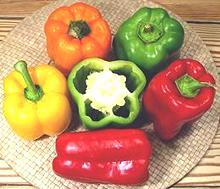 [Tian Jiao (China); Shimla Mirch (India); Capsicum (British); Bell
Peppers (North America); C. annuum]
[Tian Jiao (China); Shimla Mirch (India); Capsicum (British); Bell
Peppers (North America); C. annuum]
China is the largest grower and exporter of Bell Peppers in the world,
and they have become quite important in Chinese cuisines, particularly
in stir fries and for stuffing. In China, Red ones are the most used,
but Green are also used. Box shaped to heart shaped, these are up to 5
inches (12.7 cm) across here in California, but may be a bit smaller in
some countries. They feature thick, crisp and flavorful flesh with no
heat (H0), though occasionally one
will be found to have a faint trace of heat. The walls are very thick
with a high water content, so they are not dried except industrially
for food processors.
Note that all these specimens were ground by me in my spice grinder, as commercial flake and powder were imperfectly available. That is how it would be done in Sichuan homes as well, though probably pounded in a mortar.
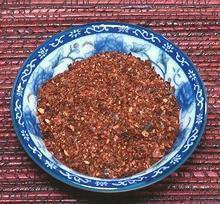
[Er Jing Tiao; Two Vitex; C.annuum]
This is a unique chili, with a strong aroma and taste, but with very moderate heat. It is dried and ground to flakes as an ingredient or as a rub or dry dip, for which it is particularly suited, with excellent flavor and distinct, but not overwhelming heat.
Subst: Chili Negro
has almost the exact same heat, though is a darker color. It is similarly
aromatic, but noticeably sweeter.

[Chao Tian Jiaom; C.annuum]
Flavor is a little lighter than the Erjingtiao chili, but it may be
even less hot.
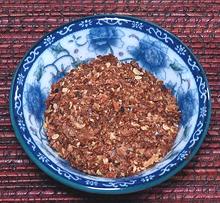
[Zi Dan Tou; C.annuum]
I have not seen this advertised in North America, but it is an
excellent, flavorful, moderately hot flake, so I presume it is ground and
used in Sichuan.
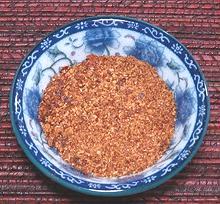
[Xiao mi la, Man tian xing; C frutescens]
Here we are getting deep into Thai-hot territory. This is used mostly
in Yunnan province, which borders Burma, Thailand and Laos. Extremely hot
and lingering, about H8.
Subst: Ground dried red Thai Chilis are an excellent
substitute. Cayenne would be significantly milder.

[Chinese Chili Pepper; Tien Tsin (China); Hontaka, Santaka, (Japan); C. annuum]
China exports vast quantities of Chili Powder marked just Chili Powder,
without any indication of type. It is mostly from Japone type chilis or
chilis of very similar heat and taste characteristics. The specimen to
the left is Japone powder.